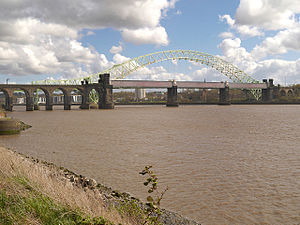Runcorn Railway Bridge
Coordinates: 53 ° 20 ′ 48 ″ N , 2 ° 44 ′ 18 ″ W.
| Runcorn Railway Bridge | ||
|---|---|---|
|
The Runcorn Railway Bridge, with the Silver Jubilee Bridge behind it |
||
| Convicted | West Coast Main Line | |
| Crossing of | River Mersey | |
| place | Runcorn - Widnes | |
| construction | Lattice girder bridge | |
| Longest span | 3 × 93 m | |
| Clear height | 22.8 m above MHW | |
| start of building | 1863 | |
| completion | 1868 | |
| planner | William Baker | |
| location | ||
|
|
||
The Runcorn Railway Bridge , also Britannia Bridge or locally Queen Ethelfleda Viaduct , leads the Liverpool branch of the West Coast Main Line over the River Mersey and the Manchester Ship Canal running next to it . It stands in the English Unitary Authority Borough of Halton between the places Runcorn and Widnes at the narrow point of the river called Runcorn Gap , before it flows into the Irish Sea in an estuary past Liverpool . It is the last bridge over the Mersey, as there are tunnels in Liverpool but no bridges.
About 30 m east of it is the Silver Jubilee Bridge , a truss - arched bridge for road traffic opened in 1961 .
description
The double-track railway bridge, designed by William Baker and built between 1863 and 1868, is one of the oldest lattice girder bridges still in regular operation.
The main bridge has three openings each 93 m wide with 8.5 m high, originally wrought iron lattice girders . At the beginning of the 20th century, wrought iron was replaced by steel. Each carrier weighs 711 tons. The girders were not made on land, as was common at the time, but joined lath for lath on the construction site with 48,115 rivets . The bridge is supported by four pillars of sandstone worn. The outer pillars are designed as crenellated castle portals. The bridge had a 600 kg fog bell to warn shipping, but it was removed during the restoration in the 2010s.
The Admiralty once required a headroom of 22.8 m (75 ft) above MHW (with a tidal range of 6 m). That required long ramp bridges. The 1175 m long viaduct on the north side has 16 round arches, which is followed by another viaduct with 49 round arches after a short dam. On the south side there is a 540 m long viaduct with 33 round arches. All the arches of the viaducts are made of brickwork.
Tradition has it that Æthelflæd , Queen of Mercia , had a fort built on the south bank in 915 , which is reflected in the name of the bridge.
The bridge is a Grade II * building under monument protection.
Web links
- Stuart Marsh: Restoration work on the Runcorn railway bridge at railengineer.co.uk
Individual evidence
- ^ Stuart Marsh: Restoration work on the Runcorn railway bridge on railengineer.co.uk
- ↑ Runcorn Bridge railway bridge over River Mersey at historicengland.org.uk

